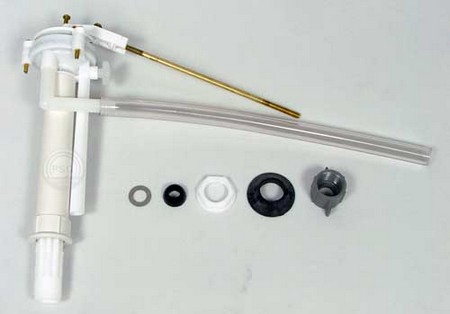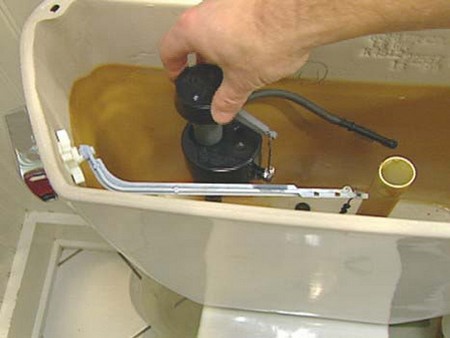Best Way to Change a Washer on Your Ballcock
I have very vivid memories of changing the washer on my own water tank ballcock. It was a chilly autumn evening, the sun was setting and dusk was rapidly approaching. The overflow pipe from the cold water storage tank in the loft had been running all day, discharging water in the area where my wife normally hangs the washing out. I had just got in from a hard day’s toil, but to please my wife I went up into the loft with a bag of tools and a torch.
This took place many years ago, and it has to be said I was a touch impetuous and didn’t prepare properly for the task in hand. I didn’t bother to set up a board in the loft to work from and was merely balancing on the joists. Now, you can guess what happened next! Not only did I slip through the ceiling, I fell through with both legs on either side of the joist! As I say, vivid, but also very painful memories, and it looked for a while as if a complete new ballcock would be required!
So… be warned! First set up a working platform, and if you don’t have permanent lighting in your loft, set up a running lead light and attach it to the rafters so that your hands are free.
Changing the Washer on a Water Tank
Shut off the water supply to the loft storage tank by turning off the stopcock. Then drain off the tank water by opening the bathroom taps. Take out the split pin from the valve, which will in turn release the float arm. Unscrew the cap at the end of the float valve, pop out the piston from the body and unscrew the piston end cap. Stop the piston rotating by inserting a slotted screwdriver into the gap. Remove all the remains of the old washer and clean the cap out with a wire wool pad and fit in the new washer. Lubricate the new washer with a touch of silicone grease. Connect the float arm to the valve, re-fix the split pin and turn the water back on.
The more recent systems have adopted the diaphragm valve system, which basically replaces the washer with a large rubber diaphragm. The idea behind it is that it is less likely to wear and it is made of plastic. Replacing the diaphragm is based on the same principle as the Portsmouth valve (nicknamed the navy valve) and the older Croydon valve (nicknamed the airforce valve). If you are not sure which valves you have or how they work, try the information box (right) or ask at your local plumbing supplies store.
Changing the Washer on a Toilet
To turn off the water supply to the toilet cistern, without interfering with the supply to the rest of the house, use a slotted screwdriver to turn the isolator valve screw. Once this is done, drain down the cistern by flushing the toilet.
Undo the top of the valve with the arm and float connected and set aside. Next, unscrew the ball valve assembly and remove the plastic piston.
Remove the old washer, ensuring that any remaining residue around the washer is carefully removed, using the pad of wire wool. Fit the new washer and lubricate it with a touch of silicone grease.
Fit all the components of the cistern back together again, turn the water back on and try flushing the loo. Hopefully, everything will work properly and you should be flush with your own success! If not, take everything apart once more and try the whole procedure again. If that doesn’t work, call a plumber!
How Valves Work
The Portsmouth valve has a solid brass rod float arm with either a copper or plastic float attached to the end. Bending the rod downwards slightly forces the float down and cuts off the valve earlier, letting less water into the tank. Bending the rod upwards opens the valve longer and allows more water into the tank. On a diaphragm valve, there is a screw on the float arm, which when turned towards the valve, lowers the water level, or when turned away allows more water into the tank.
Categories
Advertisements
Recent Articles
 How to Understand Bed Sizes – A Small Guide
How to Understand Bed Sizes – A Small Guide How to Select Some Must Have Kitchen Accessories
How to Select Some Must Have Kitchen Accessories Best Way to Change a Car Tire
Best Way to Change a Car Tire Best Way to Write an Affirmation
Best Way to Write an Affirmation Best Way to Take Charge of Your Financial Life
Best Way to Take Charge of Your Financial Life Best Way to Survive a Party When You Don’t Know Anyone
Best Way to Survive a Party When You Don’t Know Anyone Best Way to Stop Self Sabotaging Yourself
Best Way to Stop Self Sabotaging Yourself Best Way to Start Journal Writing
Best Way to Start Journal Writing Best Way to Speak with a Powerful Voice
Best Way to Speak with a Powerful Voice Best Way to Simplify Your Life
Best Way to Simplify Your Life Best Way to Respond to a Put-Down
Best Way to Respond to a Put-Down Best Way to Reduce Acne Breakouts
Best Way to Reduce Acne Breakouts Best Way to Recover from Dining Disasters
Best Way to Recover from Dining Disasters Best Way to Quit Your Job Gracefully
Best Way to Quit Your Job Gracefully Best Way to Make Your Own Website
Best Way to Make Your Own Website



Leave a Reply